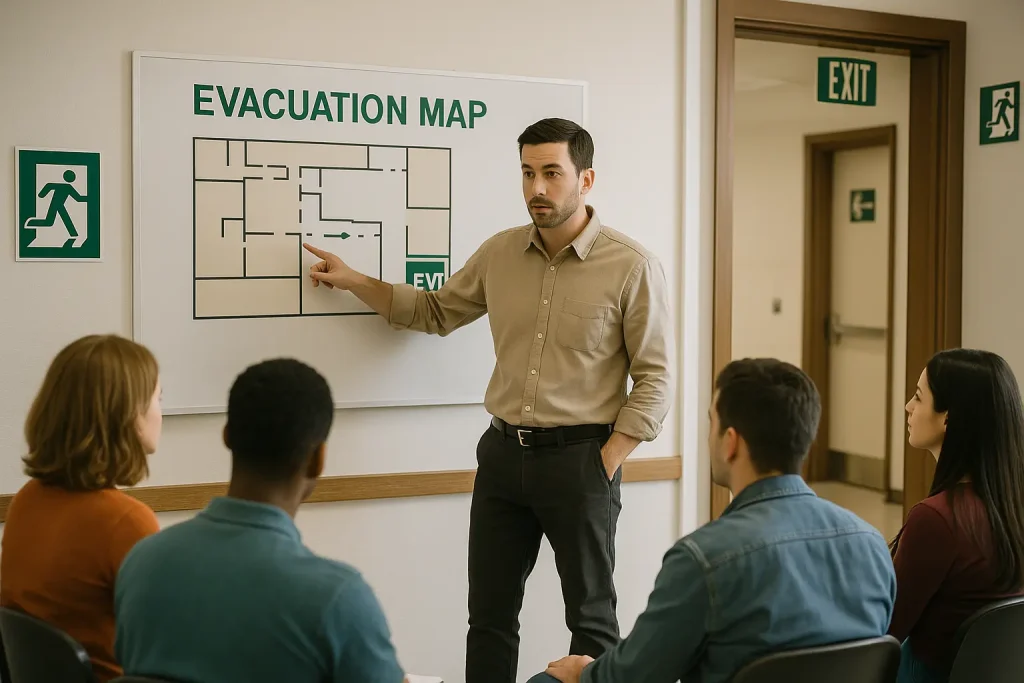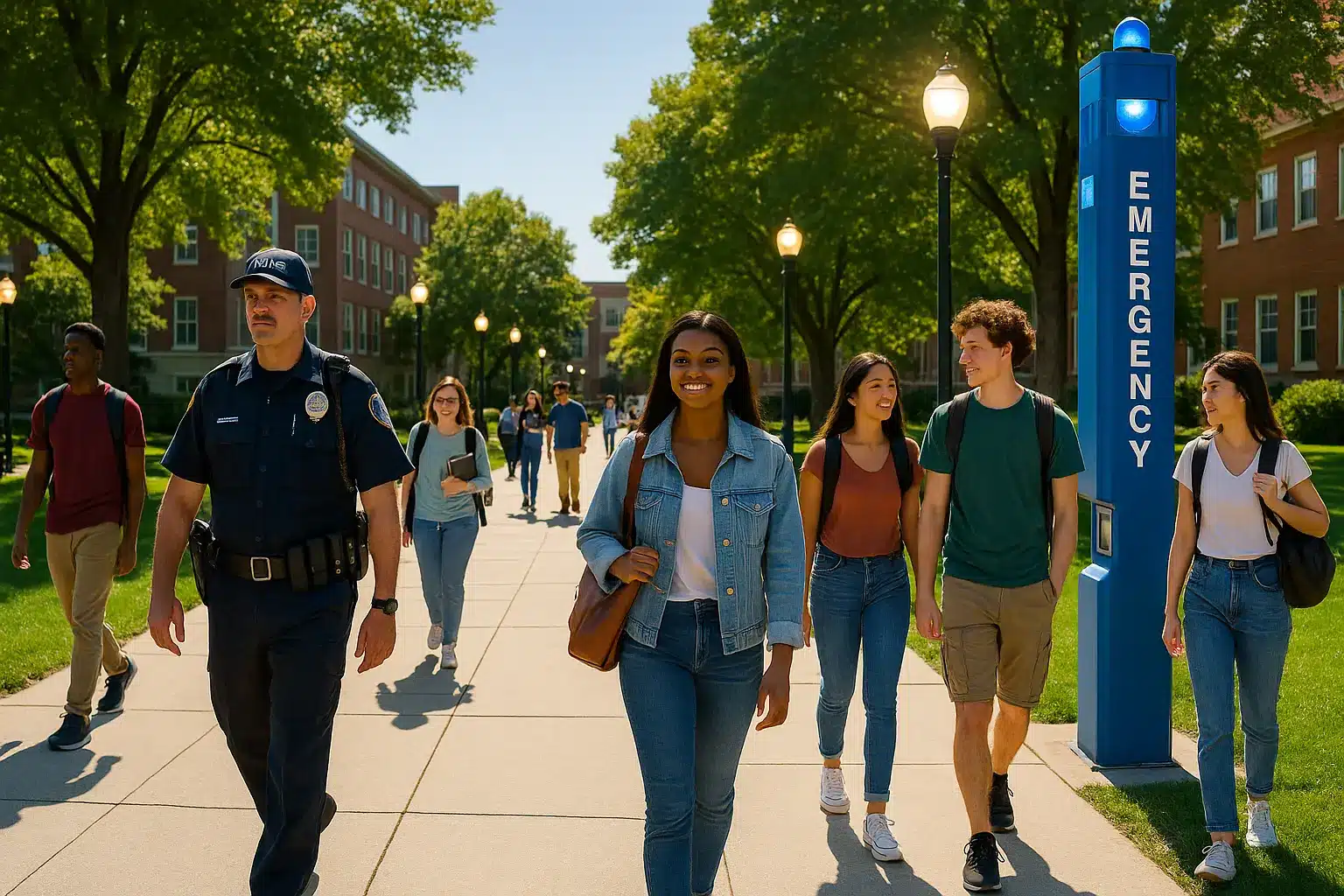A safe campus is a necessity for the success of colleges and universities, and there are several ways to achieve a high level of safety and security. This article will cover a wide range of campus safety best practices, including emergency planning, technology, training, and mental health support.
Key Takeaways
- A comprehensive safety plan, including an emergency operations plan and regular risk assessments, is key to campus security.
- Using smart surveillance and access control systems can boost safety and response times; many schools are implementing these to increase campus safety.
- Training the campus community on emergency response, providing mental health support, and establishing a proactive safety culture are all crucial components to overall campus safety.
Comprehensive Safety Planning

A safe campus requires a high level of planning and community responsibility. Developing a comprehensive safety plan is key to campus safety. They include emergency operations, risk assessments, and clear crisis communication protocols that are essential to preparation. These plans aren’t just documents; they are living frameworks. They should evolve with the needs of the campus and new threats.
Security teams play a big role in developing, implementing, and updating these safety plans to keep the campus safe. Safety plans should be built on the pillars of education, technology, infrastructure, and community responsibility. Integrating these elements creates a safety net that engages everyone from staff to students, campus police to local partners.
Emergency Operations Plan (EOP)
An effective Emergency Operations Plan (EOP) is the foundation of campus safety and an integral part of safety planning. An EOP outlines the resources available, both internal and external, and assigns roles to response teams during emergencies. A strong EOP should cover everything from fire evacuations to active shooter events and other potential threats, so that the community is prepared for all scenarios. With a clear plan established, colleges can better coordinate with themselves and local emergency services, resulting in overall reduced response times.
Emergency notification systems, discussed in more detail below, should be integrated in Emergency Operations Plans due to their significant role in the communication and information side of cs response and campus safety. Colleges should establish a direct line to campus security and emergency services for community members and administrators to use to ensure quick coordination, fast response times, and accurate location reporting in the case of an emergency situation.
Key elements of an EOP include:
- A campus overview
- Resources
- Response team roles
- Communication protocols
- Up-to-date emergency contact information
For a more detailed guide on developing an Emergency Operations Plan, view FEMA’s resources linked here and here.
Risk Assessments
Risk assessments are key to identifying potential vulnerabilities and threats specific to each college environment; the risks identified will be unique to each institution and may change from assessment to assessment. Assessments allow campuses to address dangers before they get out of hand, through the identification of areas that need attention and the following intervention. These can guide the implementation of safety measures that reduce risk and make campuses more resilient to threats.
Crisis Communication
Crisis communication is central to preparedness. Good crisis communication is highly important when it comes to managing safety incidents and getting a timely response in an emergency. Emergency Notification Systems (ENS) are highly useful in a college or university setting due to the large population size, age demographics, and density. ENS operates by sending alerts through multiple channels, like text messages, emails, mobile apps, and public address systems, to get vital information to the campus community fast. These can be utilized in a wide variety of situations and are an essential tool for mass communication.
Anonymous reporting mechanisms are also an important component of crisis communications, as they encourage students and staff to report suspicious behaviour and can help to identify threats before they escalate.
Overall, clear communication channels are necessary to achieve a high standard of safety and build a culture where everyone feels responsible for campus security.
Leveraging Technology for Campus Security

Innovations in technology have been pivotal for campus safety practices and school security systems. Integrating tools like real-time surveillance, AI object detection, and advanced access control have presented opportunities to enhance pre-existing physical security measures. This has improved overall security and allowed for immediate connection to emergency services, like emergency phones or mobile apps that connect students directly to help in the case of danger or distress.
These technologies not only make campuses safer for students, faculty, and staff, but also make security management more efficient, so a unified and effective safety strategy is possible.
Smart Surveillance Systems
Smart surveillance integration has become highly desired in campus safety due to the wide range of benefits it has shown to have. Modern surveillance cameras with artificial intelligence (AI) offer:
- Weapon or firearm detection, allowing for earlier intervention
- Preventing burnout from security personnel by offering 24/7/365 coverage, and only alerting personnel when there are potential threats
- Proactivity in identifying dangers
- Scalability and easy integration
- Enabling complete visibility across the campus
Proper lighting around entry points increases visibility and safety by deterring crime and allowing for quick identification of issues, which also helps the cameras by eliminating hiding spots. Together, AI-enhanced surveillance and proper lighting promote a safer campus.
Access Control Systems
Access control systems can be greatly enhanced with technology. Access control systems are an essential tool for regulating entry to the more secure buildings on campuses (like residence halls or campus medical offices). These systems use electronic locks and credential verification to ensure only authorized people can get in. Modern access control systems often integrate with other security measures, such as surveillance cameras and emergency notification systems, to create a comprehensive safety strategy.
By controlling entry points with technology, campuses can greatly improve their overall security and reduce unauthorized access into buildings.
Emergency Notification Systems
Advanced ENS systems, as described previously, can be critical tools for sending out timely alerts during emergencies and making campuses safer. These systems are a highly effective way of reaching all community members, including students, staff, faculty, and campus police, and they can grant people the ability to prepare and respond to crises. Providing ENS-specific training to campus police and staff members should be completed to further improve the efficacy of these systems.
Training and Preparing the Campus Community

Training and preparedness are central to the security and safety of college and university campuses. Proper training for students and staff ensures that everyone knows how to respond during emergencies, which is life and property-saving. Holding routine fire drills, offering first aid courses, establishing clear evacuation routes, and reviewing crisis communication protocols are all part of this preparation.
Another safety protocol that institutions can promote is the buddy system, where students pair up with escorts or peers for protection during late hours or uncomfortable walks. This peer safety measure is often part of campus security strategies to ensure personal safety.
By promoting a safety culture, campuses can get the community to work together to make the campus safer.
Role-Specific Training
Another aspect of preparedness to consider is role-specific training. Customised training for different roles on campus is key to emergency response. Regular role-specific training means staff and students are equipped to deal with specific situations and overall campus safety. By addressing the specific responsibilities of each role, these training programs contribute to a prepared campus community.
Involving Local Law Enforcement
Collaborating with local police is crucial to making sure everyone is on the same page. Local police can be involved in things, such as:
- Safety drills
- Improving communication and coordination during emergencies
- Strengthening response strategies
- Creating a safety network that supports overall campus security
Working with local police prepares campus staff for real emergencies and promotes a unified response.
First Aid and Mental Health Training
First aid and mental health training are important aspects of campus safety, discussed in more depth below. Offering training in these things can give individuals the skills to manage a crisis and improve the overall sense of personal and community safety on campus. These training programs ensure campus community members are prepared to help in an emergency and support peers in distress. By prioritising first aid and mental health training, campuses can be more prepared for an emergency.
Enhancing Physical Security Measures
Physical security is often the first line of defense against potential threats. Physical security measures, including reinforced entry points, good lighting, and visible security officers, are essential to safety. These measures can reduce the likelihood of crime on campuses, allowing students the opportunity to thrive.
Physical security also prevents property crimes, such as motor vehicle and bicycle theft, which is a common problem on college campuses. By focusing on physical security, campuses can make the environment safer for everyone.
Reinforced Entry Points
Reinforcing front door entry points is an important element of campus security. Strong doors and windows that can’t be forced open make it harder for intruders to get into buildings. Additionally, good lighting around these entry points can potentially deter intruders. Taking action to secure entry points makes campus buildings safer and can prevent unauthorized access.
Visible Security Officers
Visible security officers or SROs can help deter criminal activity on college campuses by:
- Increasing patrols so students and staff feel safe
- Encouraging students and staff to report suspicious or concerning activity
- Making individuals less likely to commit a crime because of the increased risk of getting caught
This visible presence significantly contributes to creating a safer campus atmosphere.
Fire Safety Protocols
Fire safety is highly important on college campuses. The high density of students living in close quarters and new responsibilities that many students are experiencing contribute to this need. NFPA estimates that emergency services respond to approximately 3,231 fire incidents annually on college campuses or related buildings, like fraternity and sorority houses.
Colleges and universities can prepare their campuses for fire safety by:
- Ensuring that all fire alarms and sprinkler systems in buildings are able to detect and prevent the spread of fire
- Establishing clear evacuation routes
- Holding regular fire drills so everyone knows what to do in the case of an emergency
Additionally, students should be made aware of personal fire safety practices. This includes not leaving candles or cooking food unattended.
Promoting Mental Health and Support Services

Proactive mental health and support services are essential for campuses to thrive. These services support the well-being of students and staff and directly impact their personal safety. Including psychological first aid training helps responders manage stress and support those affected by emergencies.
Accessible Support Services
It is essential that support is always within reach. Accessible support services help to foster a safe and supportive learning environment where well-being is a priority. These services make people feel safe to ask for help, so the overall campus is safer. Promoting positive behaviors through care and practical tips can help to improve mental health and make community members feel supported.
Confidential Support Options
Confidential options are important to offer so that students can seek help without the fear of being exposed. These services build trust and make victims feel safe. Anonymous support services can encourage victims to come forward without the worry of stigma. This improves overall safety by encouraging positive outlets.
Encouraging Responsible Behavior
Upholding a standard of accountability on campus is key to a safe and supportive college experience. Creating programs that teach students practical ways to make safe choices helps to create a culture of accountability and care, including campus activities and campus policies.
Accountability through safe choices and practical tips fosters a campus culture where safety is everyone’s priority and establishes a mutual sense of responsibility.
Building a Proactive Safety Culture
A proactive safety culture is one of care where students are empowered to and comfortable reporting concerns. This leads to prevention through community involvement and anticipating risks, creating a safe space for all campus members.
Community Policing
Community policing revolves around establishing partnerships between campus police and the community, which builds trust and communication. Shared responsibility and communication improve overall safety. Building trust and collaboration between campus police and students has the potential to make the whole community safer. Community policing is a proactive way to create a culture of care and safety on campus.
Increasing Visibility in High-Risk Areas
Increasing patrols and their visibility in high-risk areas can make students feel safer and deter criminal activity. Additionally, this proactive approach to security encourages situational awareness for community members and promotes campus safety.
Encouraging Reporting of Suspicious Activity
Encouraging reporting is key to overall safety. Confidential reporting options allow victims to report, or “tip,” without the fear of being outed or retaliation.
Summary
In summary, campus safety requires a multi-faceted approach consisting of safety planning, technology, training and preparing the campus community, physical security, mental health and support services, and a proactive safety culture. Each of these pieces is important to creating a safe and supportive space for students, staff, and faculty to be. By following these best practices, campuses can increase overall safety and well-being.
Frequently Asked Questions (FAQs)
What is the role of an Emergency Operations Plan (EOP) in campus safety?
An EOP is key to campus safety as it outlines resources, response team roles, communication protocols, and emergency contacts so that communities can act quickly and effectively in an emergency.
Why are regular risk assessments important for campus safety?
Risk assessments are important for campus safety as they identify threats and vulnerabilities so that administrators and security personnel can take proactive measures and improve overall security.
How does technology enhance campus security?
Technology helps campus security by integrating with and enhancing surveillance systems, access controls, and emergency alerts, all of which improve safety and security.
What are the benefits of involving local law enforcement in campus safety?
Involving local police in campus safety improves communication and coordination in an emergency, strengthening overall response capacity and establishing a safety network. This collaborative approach makes campuses safer.
How do mental health and support services contribute to campus safety?
Mental health and well-being services are very important to campus safety. Through initiatives like psychological first aid training and counseling services, they address the psychological and mental health needs of the community. These services help the community manage stress and can help provide support in the case of an emergency.



